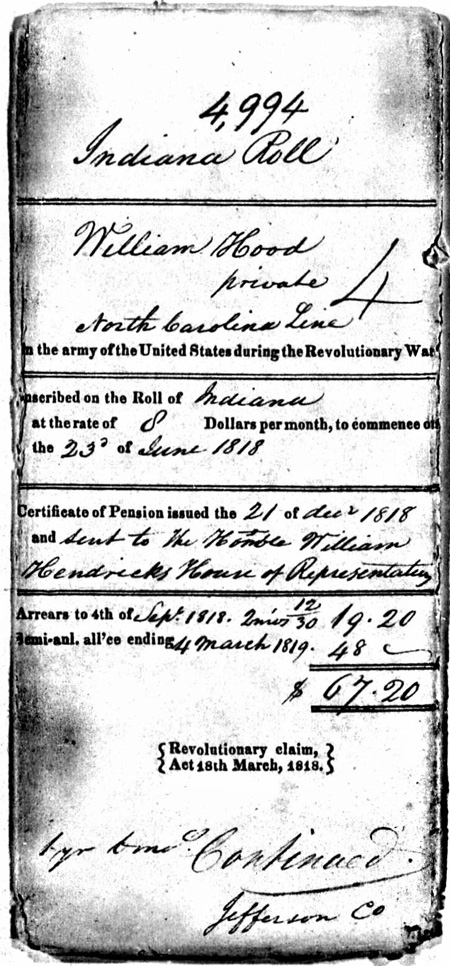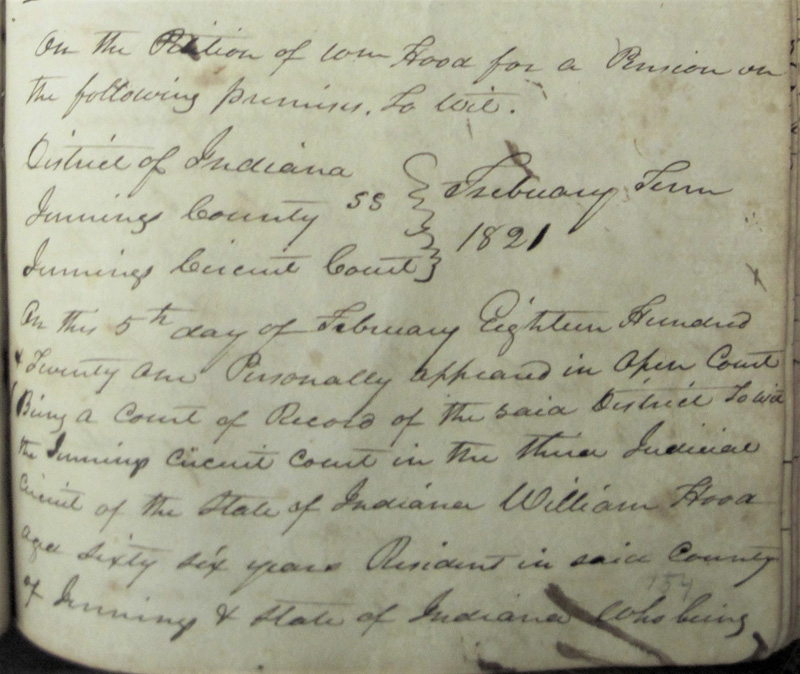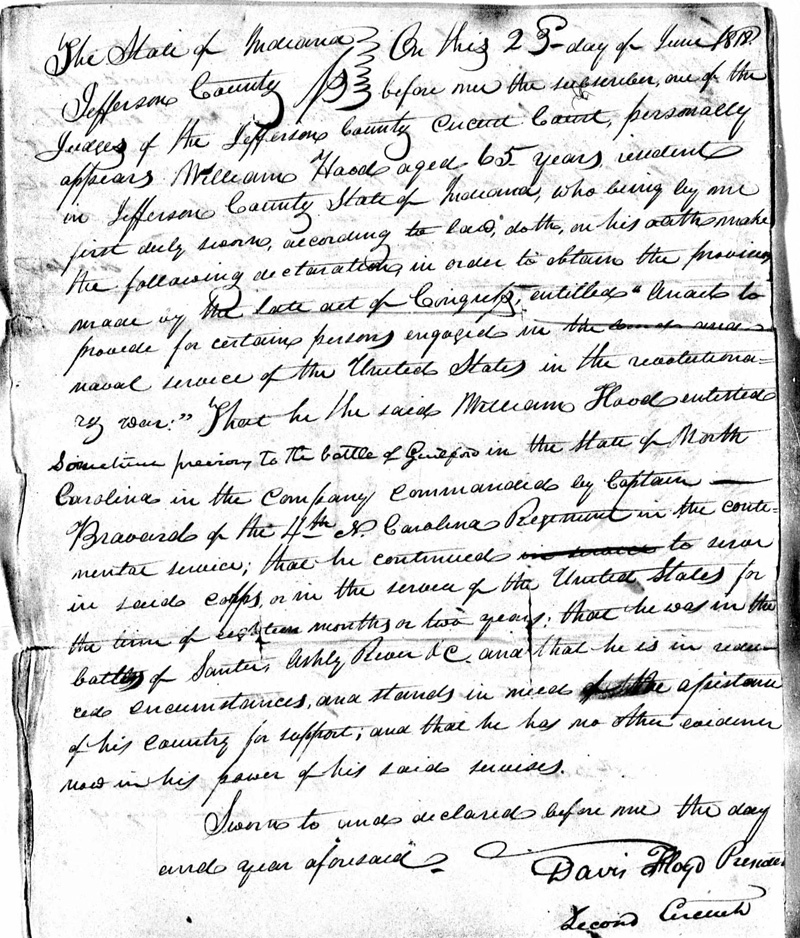WILLIAM HOOD
Revolutionary War Soldier - Jennings County Pioneer
I seldom put up a page with as many "loose ends" as this one but felt it was warranted if I hope to get a more
complete picture of William Hood and his family!
I have not found any records of another Black Revolutionary Soldier who died in Indiana but that does not mean there wasn't any. Records for Revolutionary Soldiers are difficult to come by. We are fortunate the William Hood went to court here to swear an affidavit about his service and it remains in our old court records. William first applied for and received a Pension in Jefferson County which is where he came when he first moved to Indiana.

The black & white photos on this page are from the National Archives
By 1821 William is living in Jennings County and files for his pension here.

On the Petition of Wm Hood for a Pension on the following premins. To Wit
District of Indiana
Jennings County } February Term
Jennings Circuit Court 1821
On This the 5th day of February Eighteen Hundred Twenty One Personally appeared in Open Court It being a Court of Record of the said District to wit the Jennings Circuit Court in the Third Indiana Circuit of the State of Indiana William Hood aged sixty six years Resident in said County of Jennings & State of Indiana who being first duly sworn according to Law doth on Oath declare that he served in the Revolutionary War as follows that he listed under Capt. Bravard in Colonel Archibald Lytles Regt ________ [part of page missing] it being the 4th North Carolina Regiment and his Original Certificate is dated The 21st day of Dec. 1818 and numbered 4994 [See above] And do Solemnly swear that I was a resident of the United States on the 18th day of March 1818 And that I have not by Gift Grant or sale or in any manner disposed of my property or any part thereof with an intent thereby to Diminish it or to Bring myself within the Provision of an Act of Congress Entitled an act to provide for Certain persons Engaged in the land and naval service of the United States in the Revolutionary war passed the 18th day of March 1818 And that I have not nor has any person in Trust for me any property of Securities Contracts or Debts Due to Me nor have I any income other than what is contained in the Schedule hereunto annexed and by me Subscribed I no Real Estate Personal property I have one little shovel plow one gentle Horse one sow and Eight shotes one Heifer one falling axe and one weeding hoe and one grubbing hoe I have no occupation except farming and am not able ________[missing section] that in Consequence of being much afflicted with_________[missing section] Rheumatism I have four children living with me Hannibal aged Eight years old this 19th ____[missing section] Inst Jesse six years old the 9th March next Sally four years old the 5th May next and Ellinor one year the Sept last past neither of whom are able to support themselves Sworn to and Declared on the 5th Feby 1821
Before the Honorable Wm Prather & John Barrett Judges of s'd Court
Wm Hood
X
his mark
The next time William Hood's name shows in Jennings County records is when his estate is filed in court on September 9, 1829, his widow Catherine "Kitty" Hood has refused to act as administrator for the estate so the court appoints Richard Stott as administrator. Court during this time only met quarterly so this estate works its way slowly through the courts. Richard first in November reports to the court that the estate is insolvent. In January of 1830 the estate is formally declared insolvent. Richard Stott is ordered by the court to sell the real estate belonging to William Hood and three weeks notice of the sale is published. Richard Stott comes back into court and reports that it sold to Thomas Stone and the court orders Richard Stott to make out a deed to him. The money from the sale of the property is used to pay outstanding debts and the estate is finally settled in 1831.
By doing an extensive on line search I did find this record at Free African Americans.com Here is what they have for William Hood!
William Hood was a "remarkably smart" sixteen-year-old "Mulatto boy" who had been on two voyages to sea, ran away from Henry Minson of Charles City County on 23 September 1769 and was taken up in Halifax County, North Carolina, according to the 21 December 1769 issue of the Virginia Gazette [Windley, Runaway Slave Advertisements, 1:301; Headley, 18th Century Newspapers, 169]. He was a "Mulatto" counted in the 1786 North Carolina State Census for the Caswell District of Caswell County, listed adjacent to "Mulattoes" Arthur Toney and John Wright and head of a Rockingham County, North Carolina household of 7 "other free" in 1800 [NC:491]. He was about sixty-five years old in 1818 and living in Jennings County, Indiana, when he applied for a pension [NARA, W.25781, M804, Roll 1320, frames 644-672;. After finding this, I found him in the 1800 census they mention in Rockingham County, North Carolina.
We are fortunate that his widow Catherine Hood in 1855 applied for Bounty Land. Many letters and sworn statements were generated during this process from both Jennings & Jefferson counties. The bulk of her problems came with being able to prove her marriage to William. She finally ends up being granted 160 acres in Jennings County. The picture below is one of the documents in her file that tells of William's service.

Below is my transcription of the document above.
The State of IndianaJefferson County On this 23 day of June 1818 before me the subscriber one of the Judges of the Jefferson County Circuit Court , personally appears William Hood aged 65 years resident in Jefferson County State of Indiana, who being by me first duly sword, according to said oath, on his oath makes the following declaration in order to obtain the provision made by the late act of Congress, entitled Anacted to provide for certain persons engaged in the _____ service or naval service of the United States in the revolutionary war' That he the said William Hood entered Sometime previous to the battle of Guiliford in the State of North Carolina in the Company of Captain Bravard of the 4th N. Carolina Regiment in the continental service; that he continued to serve in said corps, or in the service of the United States for the term of eighteen months or two years: that he was in the battles of Santee, Ashly River etc. and that he is in reduced circumstances, and stands in need of assistance of his country for support; and that he has no other evidence in his _____ of his said services.
Sworn to and declared before me the day and year aforesaid.
David Floyd
presider Second Circuit.
We do not have an exact burial location for William Hood, much of his family ended up living in the African American community which was located in Spener Township that consisted of at least 67 people. Many of them moved north to Michigan or Canada when the Fugitive Slave Law passed in 1851, but some members of the Hood family stayed in this area.
NOTES ON THE FAMILY
Much information on William Hood is from from a time when few records have survived. According to his testimony in his pension application he was 66 years old in
February of 1821. This means he was born in about 1755. He served on the North Carolina Line in the Revolutionary War and if you look it up you find both of the officers he mentioned
listed. 4th North Carolina Regiment The usual problem of conflicting ages and dates on records
shows up in trying to document William Hood's family.We have good documentation of his service, and of his marriage to Catherine "Kitty" Deboise and their children who are listed in his pension file; Hanibal, Elinore, Jesse and Sarah, One of the big problems is when William marries Catherine in Jefferson County he is already around 57 years old. In the 1800 census in Rockingham County County, North Carolina He is in a household of 7 people and is the person listed as head of household if we use the approximate birth year of 1755 he would have been 45 and most likely have had a family. We also have some other people named Hood who show in our 1850 census one is a William Hood age 53 and living in his household is Catherine Hood age 90, which would fit for William's (Rev.) widow Catherine. In the Negro Registry for Jennings County is listed an Ephraim Hood age 50 from Rockingham County, North Carolina who comes in on the same day as the William Hood age 53, also from Rockingham County mentioned above. I believe both of these men are sons of William Hood the Revolutionary Soldier from a previous marriage. Ephraim seems to have lived in Jackson County for a time, hopefully he and William can be tied together with more research.
MORE POSSIBLE FAMILY CONNECTIONS
Confusion - Collaboration Needed
In working on a family in an area you would usually not "assume" people with same surname are related. What changes that, is the population count in the area and if the surname
is a common one or very unusual Jennings has never been a heavily populated county, those people who show as Black in our records were a very small number. So the probability that people with the same
surname listed in local records are related goes up considerably. As mentioned earlier we had a William Hood born about 1800 in Rockingham County, North Carolina, (where the Revolutionary William Hood
lived), and in the 1850 census Caterine the probable widow of the Revolutionary William is living with this William. The younger William Hood married Frances "Fanny" Regan in Jefferson County, Indiana in 1827 and
in the 1850 has a family of 11 children listed. This William Hood has three documented marriages, the one to Frances producing his children which totaled around 13. In 1868 shortly before his death in 1873,
William married Anna (Blanks), who had been married at least twice). William Hood leaves his estate to his wife Anna and mentions only two daughters in his will. The possible descendants of our Revolutionary
William Hood in this area has grown considerably if all these people can be connected.Confusion - Collaboration Needed
Now for the confusion part. I have done considerable work over the years helping people searching for their "Patriot Ancestors" to become members of the Daughters of the American Revolution. When working on William Hood 1755-1829, I thought I would not reinvent the wheel, and just go check out what they had on him, since I also wanted to know how many African American Revolutionary Soldiers died in Indiana, I reached out to a Chapter of the D.A.R in Indianapolis. That has turned out to be a dead end. I don't want to just give up on William Hood, those people who are descended from him should know they are descentants of a Revolutionary Soldier - tons of gaps in this family to fill in - or is it I just do not know where to look? Please contact me if you are related and have more information, I would love to see some recognition of all our Revolutionary Soldiers other than scattered headstones for some in places that are nearly inaccesible now - a plaque at or near our War Memorial in the Vernon Cemetery is one thought.
You may use this material for your own personal research, however it may not be used for commercial publications without express written consent of the contributor, INGenWeb, and